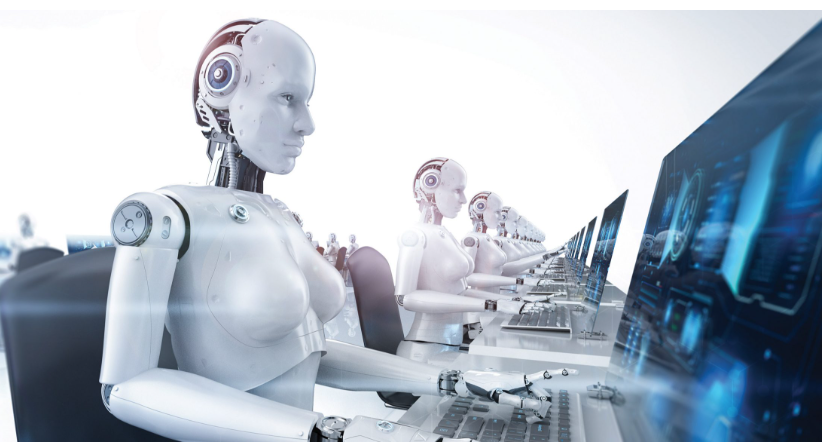“Unlock Your Potential with AI: Transforming the Future of Work”
Introduction
AI (Artificial Intelligence) has come a long way in the past few decades and has become an integral part of our daily lives. AI has been adopted in almost every industry and is being used to automate mundane tasks, improve efficiency, and power new applications. But the impact of AI on the future of work is still being debated. Will AI replace humans and make them obsolete, or can it be utilized to enable humans to do their jobs more efficiently? In this article, we will explore the potential impacts of AI on the future of work, from automation to job augmentation. We will also discuss how AI can be used to create new jobs, and how to prepare for a future that could be drastically different from today.
The Pros and Cons of Replacing Human Labor with Artificial Intelligence
The introduction of artificial intelligence (AI) into the workplace has generated significant debate, with opinions ranging from enthusiastic acceptance to anxious reactions. AI promises to revolutionize the way work is done, potentially replacing the need for human labor. On the one hand, AI automation could free up human resources, reduce costs, and increase efficiency. On the other, it could displace workers and create economic insecurity.
The primary benefit of replacing human labor with AI is the potential for increased efficiency. AI systems can be designed to quickly and accurately complete tasks that would take humans much longer. AI can also take on more complex tasks that involve analysis and decision-making. For example, AI could be used to automate processes such as data entry, customer service, and financial forecasting. This could reduce the amount of time spent on mundane tasks and allow workers to focus on more meaningful work.
Additionally, AI systems can be programmed to operate without rest, meaning they can work 24/7 without breaks. This could lead to significant cost savings for businesses, as they wouldn’t have to pay human employees for overtime. Furthermore, AI systems are not susceptible to human error, meaning they can make fewer mistakes than human workers. This could reduce costly mistakes and increase overall accuracy.
However, there are also some drawbacks to replacing human labor with AI. One of the most significant concerns is the potential for job losses. As AI systems become more sophisticated, they could take on tasks that were previously done by human workers. This could lead to large-scale job displacement, particularly in industries that rely heavily on manual labor. Furthermore, AI can be expensive to implement, meaning companies would have to invest upfront in the technology.
Finally, there is the potential for ethical issues to arise as AI systems become more prevalent in the workforce. AI systems are programmed by humans, and as such, they may reflect human biases and prejudices. This could lead to unfair decisions and could even have legal implications.
In conclusion, it is clear that replacing human labor with AI has both advantages and disadvantages. On the one hand, it could increase efficiency and reduce costs, but on the other, it could lead to job losses and ethical issues. For these reasons, it is important for businesses to carefully consider the potential implications of implementing AI systems before making a decision.
Exploring the Potential of Automation to Create New Job Opportunities
As automation technology continues to evolve, many people are wondering how it will affect the job market. While there is no doubt that automation has the potential to take over many tasks that were formerly done by people, it also has the potential to open up vast new job opportunities.
The most obvious way automation can create jobs is by freeing people up to do higher-level work and more creative tasks. Automation can take on mundane, repetitive jobs, allowing human workers to focus on more complex tasks. This can open up the need for new job roles that require more skills and creativity. For example, automation is replacing many warehouse roles with robots, but this is creating the need for more technical roles such as robotic maintenance technicians and software engineers.
Another way automation can create jobs is by enabling new business opportunities. Automation can increase efficiency, reduce costs, and open up new markets. This can create demand for workers with the skills to take advantage of these opportunities. For example, automated manufacturing has made it easier for entrepreneurs to start businesses to make custom products. This has created a need for engineers, product designers, and other professionals to help those businesses succeed.
Finally, automation can open up new job opportunities by creating demand for workers who can develop and maintain the automation technology itself. Automation requires a significant amount of research and development, as well as skilled professionals to maintain and upgrade the technology. This is creating an increased demand for software engineers, robotic technicians, and other professionals in the field.
In conclusion, while automation has the potential to take away some jobs, it is also creating new opportunities in the job market. Automation can free people up to focus on higher-level work and more creative tasks, enable new business opportunities, and create demand for workers in the automation field. With the right preparation, those who are willing to adapt can take advantage of these opportunities and find success in the new job market.
How AI Can Help Businesses Enhance Employee Productivity
Businesses are always looking for ways to increase the productivity of their employees. Artificial Intelligence (AI) is emerging as a powerful tool to help them do just that. AI can help businesses enhance employee productivity in several ways.
First, AI can automate mundane tasks, freeing up time for employees to focus on more complex and rewarding tasks. For example, AI-enabled chatbots can automate customer service inquiries, allowing customer service agents to spend more time on challenging and complex customer-related issues. AI can also be used to automate mundane administrative tasks such as data entry and document management.
Second, AI can be used to help employees make better decisions. AI-powered analytics can be used to analyze large amounts of data in order to identify patterns and anomalies, enabling employees to make more informed decisions. AI can also be used in predictive modeling, allowing businesses to anticipate future trends and plan accordingly.
Third, AI can be used to provide personalized feedback and coaching to employees. AI-powered tools can be used to analyze employee performance and provide feedback tailored to the individual. This can help employees identify areas of improvement and provide guidance on how to become more productive.
Finally, AI can be used to manage workflows and monitor employee progress. AI-powered tools can be used to assign tasks to the most appropriate employees and monitor the progress of their work. This can help businesses ensure that tasks are completed on time and that employees are meeting their goals.
By leveraging AI, businesses can enhance employee productivity in a variety of ways. AI-powered tools can automate mundane tasks, help employees make better decisions, provide personalized feedback and coaching, and manage workflows. By using AI to boost employee productivity, businesses can gain a competitive edge and achieve their goals.
Examining the Role of Machine Learning in Enhancing Employee Performance
In any organization, employee performance is an essential factor for success, and the use of machine learning has become increasingly important in helping to improve it. Machine learning is a form of artificial intelligence that enables machines to learn from data and improve their performance over time. It is a powerful tool that can be utilized to identify patterns and trends in employee behavior, enabling organizations to better understand and optimize their workforce.
Machine learning can be used to analyze large volumes of data related to employee performance, such as attendance records, time management, job performance, and job satisfaction. By leveraging predictive analytics, machine learning algorithms can identify potential areas of improvement and provide actionable insights to optimize performance. For example, machine learning can be used to analyze employee performance data to identify employees who may need additional training or support to improve their job performance. Additionally, machine learning can be used to analyze employee engagement data, such as surveys and feedback, to help identify areas for improvement in the workplace.
Machine learning can also be used to optimize existing processes and systems, such as recruitment and onboarding, to improve employee performance. The use of machine learning can help organizations streamline tedious tasks and provide a more accurate assessment of job applicants. Additionally, machine learning can be used to customize onboarding experiences for new employees to ensure they are better prepared for their role and receive the necessary training and support.
Overall, machine learning is a powerful tool that can help organizations improve employee performance in a variety of ways. By leveraging machine learning algorithms and predictive analytics, organizations can gain valuable insights into employee behavior, optimize existing processes, and provide customized onboarding experiences. Ultimately, the use of machine learning can help organizations increase employee performance and maximize their potential.
Can AI Help Bridge the Skills Gap in the Workforce?
The skills gap in the workforce is a growing concern for many industries and organizations. As technology advances and the demands of the job market change, employers must find ways to bridge the gap between the skills that their existing workforce possess and the skills that are needed to remain competitive in their industry. Artificial Intelligence (AI) can offer a solution to this problem by providing organizations with the ability to quickly and accurately assess the skills of their existing employees and identify where gaps exist.
AI can be used to create virtual assessments of employee skills and abilities. These assessments can identify the strengths and weaknesses of each individual employee, as well as identify areas where training or development may be needed. By leveraging AI, employers can easily identify which employees may need additional training or development in order to keep up with industry demands and bridge the skills gap.
AI can also be used to quickly evaluate the skills of potential new hires. AI-driven recruitment systems can quickly assess the skills, experience, and qualifications of job applicants. This allows employers to identify the best-suited candidates for a given position and ensure that the skills gaps in their existing workforce are filled with the right people.
Finally, AI can provide employers with the ability to create personalized learning and development plans for their employees. AI-driven systems can identify the skills that an employee needs to develop and create a customized training plan to help the employee reach their goals. This allows organizations to quickly and efficiently address any skills gaps in their workforce and ensure that their employees are adequately prepared for the demands of their industry.
In conclusion, AI can be an effective tool to help bridge the skills gap in the workforce. By leveraging AI-driven assessments, recruitment systems, and personalized learning plans, employers can ensure that their existing workforce has the skills needed to remain competitive in their industry.
Conclusion
The impact of AI on the future of work is certain to be profound. AI technology is rapidly advancing and its potential for improving the way we work is vast. AI will allow us to automate mundane tasks, optimize complex processes, and enable machines to do work that was previously done by humans. This shift in the labor force will create both opportunities and challenges, but ultimately, AI is likely to create a more efficient and productive work environment.


